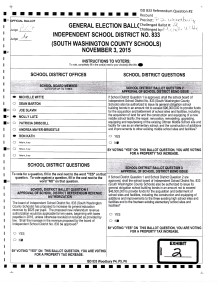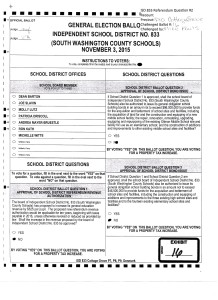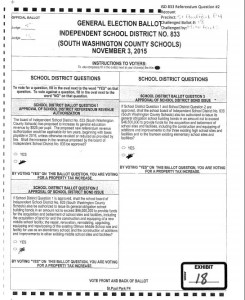The South Washington County Schools ISD 833 $96 million bond ballot Election Contest has been scheduled to go before Washington County District Court (Judge Galler) on Friday, December 18, 2015 (8:30am), and January 4, 2016 (8:30am). The December 18th date is for Judge Galler to hear and rule on each side’s arguments for motions filed with the court.
On December 8, 2015, ISD 833 attorneys filed their “Answer” and “Memorandum” to the “Notice of Election Contest” (contesting the election results of the $96 million bond “Question 2”) filed on December 2, 2015 by Attorney Erick Kaardal in Washington County District Court.
The school district’s attorneys, Michelle D. Kenney and Stephen M. Knutson (Knutson, Flynn & Deans, PA) argue that the entire case should be dismissed. However, should the court not follow Kenney and Knutson’s recommendation to just throw out the entire case, they are also asking Judge Galler to grant their request to require the Contestants (Plaintiffs) to file a $9.3 million Surety Bond (in addition to the $5000 court bond, which covers the District’s court fees if the Contestants lose the case) “for the protection of the School District and its taxpayers.”
Knutson and Kenney claim “the School District and its taxpayers will be subject to increased construction costs as well as additional interest costs” if the “present action delays the sale of the voter approved bonds” as the reason for the demand the three plaintiffs pay a $9.3 million surety bond. Knutson and Kenney provided affidavits from the Bond Sales firm, Ehler’s (Sutter), Attorney Thomas Deans (of Knutson, Flynn & Deans, PA) and Attorney Michelle Kenney attesting to the expenses caused if this case drags out into the spring. As well as asking for the plaintiffs to pay $9.3 million, Kenney and Knutson also have requested that the court shorten the time and schedule of the motions and hearings on the case and request a summary judgement. However, when the Judge gave two date options – December 24, 2015 and January 4, 2016 – the District’s attorneys replied that the later date, January 4, was their preference, implying that the case may be wrapped at the motions hearing on December 18. The District’s motion for the order that plaintiffs file the $9.3 million surety bond will also be heard on December 18.
In the Contestants’ filing of the “Notice of Contest and Election Contest,” Kaardal requested that “while filing a cash bond of a minimum of $5000, nevertheless, should not be required to file any surety bond under the circumstances of this election contest” (emphasis added) and that “Order that no surety bond is required in this case because of the reasonable likelihood that Contestants will prevail and that filing the bond would impose an undue hardship on the Contestants…” According to the plaintiffs, a $9.3 million surety bond would “impose an undue hardship” on any one filing a challenge, but especially on three women, two of whom are primarily stay-at-home moms and one who owns a small home business (daycare provider). The initial $5000 court bond filed on December 2 was not provided by Susan Richardson, Andrea Mayer-Bruestle and Leilani Holmstadt themselves, but rather through donations from generous and concerned members of the ISD 833 community supportive of the efforts to preserve the integrity of the November 3 election and believe that it is imperative that the five contested ballots are seen and judged upon by the court.
In an email Susan Richardson stated:
We firmly believe that the best protection of the taxpayer is voter integrity. Had the Canvassing Board followed MN Statute 204C.22 which states ‘a ballot shall not be rejected for a technical error that does not make it impossible to determine the voter’s intent’, all of the challenged ballots would have been accepted and the bond would have failed. Because the law was not followed, 5 voters have been disenfranchised. For election integrity to be preserved, count all of the ballots.
The District and its attorneys argue that the court does not have jurisdiction over the election contest and for that reason (among others cited in the Memorandum) the case should be dismissed. However, barring dismissal, they are claiming that the Contestants must file a $9.3 million surety bond, which, if the judge rules with the district attorneys, will most likely cause Susan Richardson, et al. to withdraw the suit as raising the $9.3 million required for the surety bond by January 4, 2016, is well outside the realm of reality.
Which taxpayers are the District protecting with their request for a court ordered $9.3 million surety bond? How does requiring three citizens to submit millions of dollars in order to exercise their right to challenge the decision of the District’s Canvassing Board “protect taxpayers”? The Contestants live in ISD 833 and pay taxes in ISD 833 (taxes that are projected to increase 24% with the passage of the District’s $10.3 million/year operating levy, increases in the non-voter approved levies, and the contested $96 million bond next year): does the $9.3 million surety bond protect them and/or those in the community supporting the case moving forward?
Kraus Anderson, Ehler’s, ARY Architects and several unions are just a few of the entities poised to gain from the passage of the $96 million bond. For example, it was reported in December 2014 that Kraus Anderson was given a no-bid Construction Management contract by the ISD 833 School Board for the construction proposed if the two bond ballot questions were approved by the community – $142.5 million total – of which KA would receive 1.75% or about $2.5 million. With the defeat of Q3 ($46.5 million bond) KA’s profit drops to about $1.6 million, and hinges on the five contested ballots either never being seen by a judge or the judge upholding the Canvassing Board’s decision.
Five ballots stand between the passage of $96 million bond and its defeat: on one side, challengers asking a judge to uphold election integrity and restore the five disenfranchised voters’ ballots; on the other side, a District claiming a $9.3 million surety bond will “protect taxpayers” and that the Canvassing Board’s decision stand so that the $96 million bond passes.






















